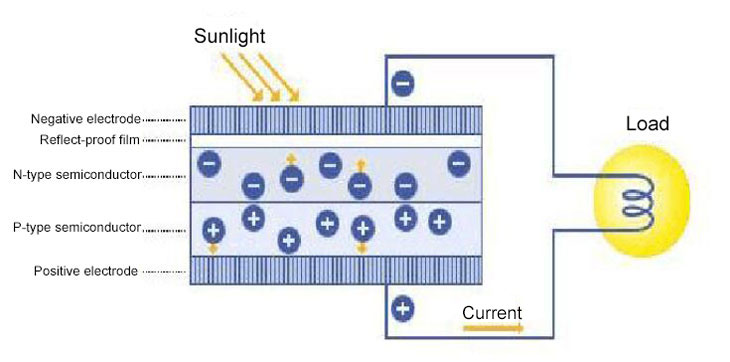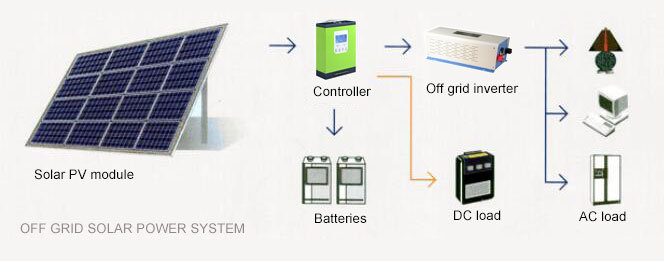The solar power system is used to convert the solar energy directly into the electric power via the solar cell module. The solar cell module is a solid device, which makes use of electronic characteristics of semiconductor materials to realize P-V conversion. In many areas without the power grid, the solar photovoltaic system can facilitate the lighting and domestic power supply for users. In some developed areas, it can be connected with the regional power grid to realize complementation. Then, how does the solar PV system work to generate the electricity used in our daily life?
How does a solar power system produce energy?
The solar power system is made up of the solar cell module, solar charge controller, storage battery (pack), inverter, lamp or other loads. Among them, the solar cell and the storage batteries are the power source system, the charge controller and solar inverter are the control and protection system, and the loads like lamps are terminals of the system. The following schematic diagram shows how every part of solar photovoltaic system works.

Solar cell module
The solar cell is a devices which can react with the light and convert the solar energy into the electric power. The main principle of solar cell power generation is the photoelectric effect of semiconductors. There are a variety of materials which can generate the photovoltaic effect, such as the monocrystalline silicon, polycrystalline silicon, amorphous silicon (A-Si), gallium arsenide, and copper indium gallium diselenide (CulnSe). Their power generation principle is generally the same.
In the following part, the crystalline silicon is taken for an example to show the photoelectric generation process. With the adulteration of phosphorous in the P-type crystalline silicon, the N-type silicon can be obtained, and the P-N node can be formed. When rays of light penetrate the solar cell surface, part of photons is absorbed by silicon materials. The photons’ energy is transmitted to the silicon atom to result in transition of electrons, which will then become free electrons to form the potential difference through gathering on two sides of the P-N node. When it is external connected with the circuit, the current will flow through the external circuit under the effect of the voltage to generate specific output power. This process is in essence to transmit the solar energy into the electric power.

Storage battery
The DC electricity generated by the solar cell is first stored in the storage batteries. The characteristics of the storage batteries can influence the working efficiency and characteristics of the whole solar power system. So far, the battery technology has been quite mature, but its capacity is subject to the influence of the terminal power demand and sunshine duration (time of power generation). Therefore, the watt-hour capacity and ampere-hour capacity of the batteries are decided by the continuous non-sunshine duration.
Solar charge controller
The solar charge controller is applied to the solar power generation system to further regulate and control the battery’s discharge and charge conditions. Meanwhile, according to the power demand of the load, the charge controller manages the electric output of the solar cell module and batteries to the load. It can ensure the solar power system to be nearby the maximum power point of power generation to acquire the highest efficiency.
Solar inverter
The solar inverter can convert DC power of the batteries into the AC power. So, how the inverter realizes this inversion from DC to AC? Through the full-bridge converter of the solar inverter, the SPWM processor is usually adopted to obtain the pure sine wave AC power matches with the frequency and rated voltage of the lighting or other loads for terminal users through modulation, filtering, and boosting. The solar inverters can be divided into the off grid inverter and the on grid inverter by the operation mode. Similarly, the solar power system can also be divided into grid tie (or on grid) and off grid power system based on operation mode.
 Why choose the solar power to generate electricity?
Why choose the solar power to generate electricity?
Compared with the commonly-used power generation system, the solar power generation has many unique advantages.
- The solar energy is an inexhaustible clean energy.
- The solar energy is safe, reliable, noise-free, and pollution-free.
- The solar energy is free of the regional limitations, and the building roof is a favorable place to gather solar energy.
- Solar power generation calls for no consumption of fuels and erection of power transmission circuits, which can reduce the operation costs, and facilitate installation and maintenance.
- Solar power generation features a short construction period, a long service life of power generation modules, flexible power generation modes, and a short energy recycling period of the power generation system.
